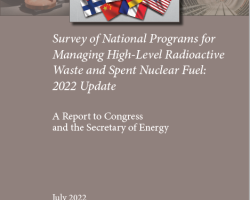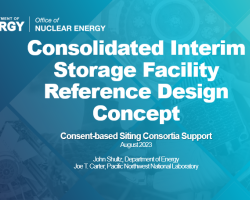Category of Content
Siting Experience Documents Only
Publication Date
Subject Matter
Keywords
Ductility of M5® and ZIRLO® Sibling Pin Cladding
Ductility of M5® and ZIRLO® Sibling Pin Cladding
Ductility of M5 and ZIRLO Sibling Pin Cladding
Ductility of M5 and ZIRLO Sibling Pin Cladding
Ductility of High-Burnup-Fuel ZIRLO™ following Drying and Storage, Rev 3
Ductility of High-Burnup-Fuel ZIRLO™ following Drying and Storage, Rev 3
Used Fuel Disposition Storage, Transportation and Disposal Interface Study
Used Fuel Disposition Storage, Transportation and Disposal Interface Study
Thermal-Hydraulic Results for the Boiling Water Reactor Dry Cask Simulator
Thermal-Hydraulic Results for the Boiling Water Reactor Dry Cask Simulator
Cost Implications of an Interim Storage Facility in the Waste Management System
Cost Implications of an Interim Storage Facility in the Waste Management System
Generic Design Alternatives for Dry Storage of Spent Nuclear Fuel
Generic Design Alternatives for Dry Storage of Spent Nuclear Fuel
Generic Design Alternatives for Dry Storage of Spent Nuclear Fuel
Generic Design Alternatives for Dry Storage of Spent Nuclear Fuel
Generic Design Alternatives for Dry Storage of Spent Nuclear Fuel
Generic Design Alternatives for Dry Storage of Spent Nuclear Fuel
Multi-Year Plan to Prepare DOE-Managed Spent fuel for Transportation
Multi-Year Plan to Prepare DOE-Managed Spent fuel for Transportation
Potential Cost Implications of an Interim Storage Facility for Commercial SNF
Potential Cost Implications of an Interim Storage Facility for Commercial SNF
Generic Design Alternatives for Dry Storage of Spent Nuclear Fuel
Generic Design Alternatives for Dry Storage of Spent Nuclear Fuel
Cost Sensitivity Analysis for Consolidated Interim Storage of Spent Fuel: Evaluating the Effect of Economic Environment Parameters
Cost Sensitivity Analysis for Consolidated Interim Storage of Spent Fuel: Evaluating the Effect of Economic Environment Parameters
Generic Design Alternatives for Dry Storage of Spent Nuclear Fuel
Generic Design Alternatives for Dry Storage of Spent Nuclear Fuel
Mothers for Nuclear Flyer
Mothers for Nuclear Flyer
Mothers for Nuclear Informational Flyer
Interim Storage, Environmental Justice, and Generational Equity
Interim Storage, Environmental Justice, and Generational Equity
With the termination of the Yucca Mountain project, which was proposed to be our nation’s first repository for the disposal of military and civilian spent nuclear fuel and high-level radioactive waste, the future of nuclear waste management and disposal in this country became increasingly uncertain. Interim storage has been advocated by many as a temporary solution while a permanent solution is studied for potentially several more decades to come.
Community Involvement Plan: Area IV, Santa Susana Field Laboratory
Community Involvement Plan: Area IV, Santa Susana Field Laboratory
As a result of the 2007 ruling by the U.S. District Court of Northern California that the DOE must prepare an Environmental Impact Statement (EIS) to evaluate alternatives for cleanup of Area IV of the SSFL, DOE has implemented major changes in its management of SSFL Area IV. As an initial step, this community involvement plan (CIP) outlines a series of activities and programs that intend to engage the public, establish transparency in DOE actions and decisions, and increase input from the community.
Topical Analysis of Nuclear Experts' Perceptions of Publics, Nuclear Energy, and Sustainable Futures
Topical Analysis of Nuclear Experts' Perceptions of Publics, Nuclear Energy, and Sustainable Futures
Nuclear energy experts consider commercial power from fission to be a strong contender to help mitigate the increasing effects of climate change, in part due to its low-to-no carbon emissions. Nevertheless, nuclear energy's history, including meltdowns such as Three Mile Island, Chernobyl, and Fukushima, and dumping in sacred Indigenous land such as Yucca Mountain, raises important concerns in public deliberation over nuclear power.
Nuclear power and the public: an update of collected research on nuclear power
Nuclear power and the public: an update of collected research on nuclear power
The purpose of this research was to collect, analyze, and summarize all of the nuclear power-related surveys conducted in the United States through June, 1981, that we could obtain. The surveys collected were national, statewide, and areawide in scope. Slightly over 100 surveys were collected for an earlier, similar effort carried out in 1977. About 130 new surveys were added to the earlier survey data. Thus, about 230 surveys were screened for inclusion in this report.
Monitored Retrievable Storage Facility Conceptual Design Report
Monitored Retrievable Storage Facility Conceptual Design Report
Survey of National Programs for Managing High-Level Radioactive Waste and Spent Nuclear Fuel: 2022 Update
Survey of National Programs for Managing High-Level Radioactive Waste and Spent Nuclear Fuel: 2022 Update
In October 2009, the U.S. Nuclear Waste Technical Review Board (Board or NWTRB) published Survey of National Programs for Managing High-Level Radioactive Waste and Spent Nuclear Fuel. For each of the 13 national programs studied, the report catalogued 15 institutional arrangements that had been set in place and 15 technical approaches that had been taken to design repository systems for the long-term management of high-activity radioactive waste.
Consolidated Interim Storage Facility Reference Design Concept
Consolidated Interim Storage Facility Reference Design Concept
Presentation slides on the Consolidated Interim Storage Facility Reference Design Concept, including site plans; handling, inspection and repackaging concepts and facilities; and cost and staffing estimates.
Summary of Consolidated Interim Storage Advantages and Disadvantages from an Integrated Systems Perspective from Prior Reports and Studies
Summary of Consolidated Interim Storage Advantages and Disadvantages from an Integrated Systems Perspective from Prior Reports and Studies
The question of whether centralized storage of civilian spent nuclear fuel (SNF) should be part of the federal waste management system as an intermediate step before permanent disposal has been debated for more than four decades. Centralized storage facilities were included as a potential component of the U.S. spent fuel management system in the Nuclear Waste Policy Act of 1982 (NWPA), but the NWPA did not identify these facilities as being essential.



